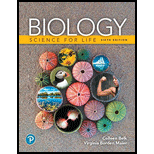
EBK BIOLOGY:SCIENCE F/LIFE
6th Edition
ISBN: 9780134819167
Author: BELK
Publisher: PEARSON
expand_more
expand_more
format_list_bulleted
Concept explainers
Question
Chapter 19, Problem 7LTB
Summary Introduction
To determine:
If the given statement that ‘Most of the digestion of nutrients occurs across the membrane that lines the interior stomach wall’ is true or false.
Introduction:
The human
Expert Solution & Answer
Want to see the full answer?
Check out a sample textbook solution
Students have asked these similar questions
fat molecules that have been absorbed from the digestive tract first enter the blood at:
at capillaries lining the stomach wall
at capillaries surrounding lacteals in the intestinal villi
at capillaries near the basal membrane of the intestinal mucosa
at the right and left subclavian veins
The process by which the products of digestion pass from the lumen of the gastrointestinal tract into the blood or lymph is:
absorption
defecation
digestion
peristalsis
The cephalic phase of digestion:
is an immediate response to stomach distension
begins when someone smells and initially tastes food.
is inhibited by cholecystokinin and secreted from the small intestine
includes the initial steps of chemical protein digestion
All of the above
Knowledge Booster
Learn more about
Need a deep-dive on the concept behind this application? Look no further. Learn more about this topic, biology and related others by exploring similar questions and additional content below.Similar questions
- List the organs and accessory organs of the digestive system. On a separate piece of paper, list the main functions of each organ.arrow_forwardFigure 34.19 Which of the following statements about digestive processes is true? Amylase, maltaseT and lactase in the mouth digest carbohydrates. Trypsin and lipase in the stomach digest protein. Bile emulsifies lipids in the small intestine. No food is absorbed until the small intestine.arrow_forwardDigestion is completed and products are absorbed in the _________. a. mouth b. stomach c. small intestine d. large intestinearrow_forward
- Match the digestive system parts and functions.arrow_forwardFigure 34.11 Which of the following statements about the digestive system is false? Chyme is a mixture of food and digestive juices that is produced in the stomach. Food enters the large intestine before the small intestine. In the small intestine, chyme mixes with bile, which emulsifies fats. The stomach is separated from the small intestine by the pylloric sphincter.arrow_forwardThe lack of adequate saliva due to the absence of or diminished secretions by the salivary glands is known as zerostomia. _____________________arrow_forward
- Figure 34.12 Which of the following statements about the small intestine is false? Absorptive cells that line the small intestine have microvilli, small projections that increase surface area and aid in the absorption of food. The inside of the small intestine has many folds, called villi. Microvilli are lined with blood vessels as well as lymphatic vessels. The inside of the small intestine is called the lumen.arrow_forwardMatch the following processes of the Digestive System to their specific description. Match each item to a choice: Choices: Defecation Digestion Secretion Mixing and propulsion Ingestion Absorption the process by which food material are mixed together and propelled within the GI tract. the process by which micro molecules from the process of digestion are absorbed within the small intestine. the chemical and mechanical process of degrading food material into small particles. the act of taking something (food, medicine, liquid, poison etc.) into the body through the mouth. the process by which undigested food particle are expelled out of the body. the process by which chemical enzymes are secreted by the Digestive System aiding Digestion.arrow_forwardThe salivary glands, pancreas, liver and gall bladder are considered accessory organs in the digestive system. They are not part of the digestive track but contribute to digestion. List the accessory organ associated with each the following functions. Produces bicarbonate to neutralize acidity as stomach contents enter the small intestine. Stores and releases bile to aid in breakdown of fats. Produces bile. Produces enzymes that enter the small intestine and aid in digestion. Moistens food Produces salivary amylase Produces hormones that regulate blood glucose levels. Stores glucose as glycogen (a polysaccharide)arrow_forward
- The main chemical activity of the stomach is to begin the digestion of carbohydrates. True Falsearrow_forwardEnzymatic digestion of carbohydrates starts in the mouth. True Falsearrow_forwardFunctions of the stomach include all of the following, except initiation of protein digestion. mechanical breakdown of food. storage of ingested food. absorption of dipeptides. denaturation of proteins.arrow_forward
arrow_back_ios
SEE MORE QUESTIONS
arrow_forward_ios
Recommended textbooks for you
 Human Physiology: From Cells to Systems (MindTap ...BiologyISBN:9781285866932Author:Lauralee SherwoodPublisher:Cengage Learning
Human Physiology: From Cells to Systems (MindTap ...BiologyISBN:9781285866932Author:Lauralee SherwoodPublisher:Cengage Learning Comprehensive Medical Assisting: Administrative a...NursingISBN:9781305964792Author:Wilburta Q. Lindh, Carol D. Tamparo, Barbara M. Dahl, Julie Morris, Cindy CorreaPublisher:Cengage Learning
Comprehensive Medical Assisting: Administrative a...NursingISBN:9781305964792Author:Wilburta Q. Lindh, Carol D. Tamparo, Barbara M. Dahl, Julie Morris, Cindy CorreaPublisher:Cengage Learning Medical Terminology for Health Professions, Spira...Health & NutritionISBN:9781305634350Author:Ann Ehrlich, Carol L. Schroeder, Laura Ehrlich, Katrina A. SchroederPublisher:Cengage Learning
Medical Terminology for Health Professions, Spira...Health & NutritionISBN:9781305634350Author:Ann Ehrlich, Carol L. Schroeder, Laura Ehrlich, Katrina A. SchroederPublisher:Cengage Learning Human Biology (MindTap Course List)BiologyISBN:9781305112100Author:Cecie Starr, Beverly McMillanPublisher:Cengage Learning
Human Biology (MindTap Course List)BiologyISBN:9781305112100Author:Cecie Starr, Beverly McMillanPublisher:Cengage Learning



Human Physiology: From Cells to Systems (MindTap ...
Biology
ISBN:9781285866932
Author:Lauralee Sherwood
Publisher:Cengage Learning

Comprehensive Medical Assisting: Administrative a...
Nursing
ISBN:9781305964792
Author:Wilburta Q. Lindh, Carol D. Tamparo, Barbara M. Dahl, Julie Morris, Cindy Correa
Publisher:Cengage Learning

Medical Terminology for Health Professions, Spira...
Health & Nutrition
ISBN:9781305634350
Author:Ann Ehrlich, Carol L. Schroeder, Laura Ehrlich, Katrina A. Schroeder
Publisher:Cengage Learning

Human Biology (MindTap Course List)
Biology
ISBN:9781305112100
Author:Cecie Starr, Beverly McMillan
Publisher:Cengage Learning